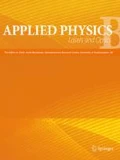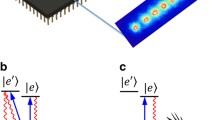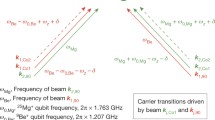Abstract
We describe the concept and experimental demonstration of the basic building blocks of a scalable quantum computer using trapped-ion qubits. The trap structure is divided into subregions where ion qubits can either be held as memory or subjected to individual rotations and multi-qubit gates in processor zones. Thus, ion qubits can become entangled in one trapping zone, then separated and distributed to separate zones (by switching control-electrode potentials) where subsequent single- and two-ion gates, and/or detection is performed. Recent work using these building blocks includes (1) demonstration of a dense-coding protocol, (2) demonstration of enhanced qubit-detection efficiency using quantum logic, (3) generation of GHZ states and their application to enhanced precision in spectroscopy, and (4) the realization of teleportation with atomic qubits. In the final section an analog quantum computer that could provide a shortcut towards quantum simulations under requirements less demanding than those for a universal quantum computer is also described.
Similar content being viewed by others
References
J.I. Cirac, P. Zoller: Phys. Rev. Lett. 74, 4091 (1995)
M.A. Nielsen, I.L. Chuang: Quantum Computation and Quantum Information, 1st edn. (Cambridge University Press, Cambridge 2000)
D.J. Wineland, C.R. Monroe, W.M. Itano, D. Leibfried, B.E. King, D.M. Meekhof: J. Res. Natl. Inst. Stand. Technol. 103, 259 (1998)
D. Kielpinski, C. Monroe, D.J. Wineland: Nature 417, 709 (2002)
M.D. Barrett, B.L. DeMarco, T. Schaetz, D. Leibfried, J. Britton, J. Chiaverini, W.M. Itano, B.M. Jelenkovic, J.D. Jost, C. Langer, T. Rosenband, D.J. Wineland: Phys. Rev. A 68, 042302 (2003)
B.B. Blinov, L. Deslauriers, P. Lee, M.J. Madsen, R. Miller, C.R. Monroe: Phys. Rev. A 65, 040304 (2002)
J. Bollinger, D.J. Heinzen, W.M. Itano, S.L. Gilbert, D.J. Wineland: IEEE Trans. Instrum. Meas. 40, 126 (1991)
R.P. Feynman, F. Vernon, R.W. Hellwarth: J. Appl. Phys. 28, 49 (1957)
L. Allen, J.H. Eberly: Optical Resonance and Two-level Atoms (Dover, Mineola, NY 1987)
The laser-beam waists (approximately equal to the beam diameters) at the ions were approximately 30 μm
D. Kielpinski, V. Meyer, M.A. Rowe, C.A. Sackett, W.M. Itano, C.R. Monroe, D.J. Wineland: Science 291, 1013 (2001)
D. Leibfried, B.L. DeMarco, V. Meyer, D. Lucas, M.D. Barrett, J. Britton, J. Chiaverini, W.M. Itano, B.M. Jelenkovic, C. Langer, T. Rosenband, D.J. Wineland: Nature 422, 414 (2003)
D.J. Wineland, M.D. Barrett, J. Britton, J. Chiaverini, B.L. DeMarco, W.M. Itano, B.M. Jelenkovic, C. Langer, D. Leibfried, V. Meyer, T. Rosenband, T. Schaetz: Philos. Trans. R. Soc. Lond. A 361, 1349 (2003)
The state of two qubits can be described in the Bell basis, spanned by four maximally entangled states [2]: the singlet state |↑↓〉-|↓↑〉 and the triplet states |↑↑〉+|↓↓〉, |↑↓〉+|↓↑〉, and |↑↑〉-|↓↓〉, respectively
D. Wineland, H. Dehmelt: Bull. Am. Phys. Soc. 20, 637 (1975); R. Blatt, P. Zoller: Eur. J. Phys. 9, 250 (1988)
http://qist.lanl.gov/
B.E. King, C.S. Wood, C.J. Myatt, Q.A. Turchette, D. Leibfried, W.M. Itano, C.R. Monroe, D.J. Wineland: Phys. Rev. Lett. 81, 1525 (1998)
T. Schaetz, M.D. Barrett, D. Leibfried, J. Chiaverini, W.M. Itano, J.D. Jost, C. Langer, D.J. Wineland: Phys. Rev. Lett. (2004) in press
C.H. Bennett, S.J. Wiesner: Phys. Rev. Lett. 69, 2881 (1992)
To preserve a superposition or an entangled state, no measurement that would cause the projection into some other states is allowed. A Bell-state measurement can be accomplished by transforming from the Bell basis [14] into the measurement basis, prior to the individual state measurement of each qubit. Therefore, the Bell measurement provides information about which of the four Bell states the two qubits were previously in, but no information about the states of the individual qubits. We realize this by a conditional (disentangling) phase gate followed by individual read out of the two qubits [18]
K. Mattle, H. Weinfurter, P.G. Kwiat, A. Zeilinger: Phys. Rev. Lett. 76, 4656 (1996)
T. Schaetz et al.: submitted for publication (2004)
D.P. DiVincenzo: in Scalable Quantum Computers, ed. by S.L. Braunstein, H.-K. Lo, P. Kok (Wiley-VCH, 2001)
D. Leibfried, M.D. Barrett, T. Schaetz, J. Britton, J. Chiaverini, W.M. Itano, J.D. Jost, C. Langer, D.J. Wineland: Science 304, 1476 (2004)
D.J. Wineland, J.J. Bollinger, W.M. Itano, F.L. Moore, D.J. Heinzen: Phys. Rev. A 46, R6797 (1992)
The statistical limit is governed by quantum projection noise, arising due to the statistical nature of projecting a superposition state into one eigenstate by the measurement
D.M. Greenberger, M.A. Horne, A. Shimony, A. Zeilinger: Am. J. Phys. 58, 1131 (1990)
M.D. Barrett, J. Chiaverini, T. Schaetz, J. Britton, W.M. Itano, J.D. Jost, E. Knill, C. Langer, D. Leibfried, R. Ozeri, D.J. Wineland: Nature 429, 737 (2004)
C.H. Bennett, G. Brassard, C. Crépeau, R. Jozsa, A. Peres, W.K. Wootters: Phys. Rev. Lett. 70, 1895 (1993)
H. Rohde, S.T. Gulde, C.F. Roos, P.A. Barton, D. Leibfried, J. Eschner, F. Schmidt-Kaler, R. Blatt: J. Opt. B 3, 34 (2001)
D. Porras, J.I. Cirac: Phys. Rev. Lett. 92, 207901 (2004)
E. Jané, G. Vidal, W. Dür, P. Zoller, J.I. Cirac: quant-ph/0207011 (2002)
Q.A. Turchette, C.J. Myatt, B.E. King, C.A. Sackett, D. Kielpinski, W.M. Itano, C.R. Monroe, D.J. Wineland: Phys. Rev. A 62, 053807 (2000)
Author information
Authors and Affiliations
Corresponding author
Additional information
PACS
03.67.Lx; 32.80.Qk
Rights and permissions
About this article
Cite this article
Schaetz, T., Leibfried, D., Chiaverini, J. et al. Towards a scalable quantum computer/simulator based on trapped ions. Appl. Phys. B 79, 979–986 (2004). https://doi.org/10.1007/s00340-004-1652-x
Received:
Revised:
Published:
Issue Date:
DOI: https://doi.org/10.1007/s00340-004-1652-x




